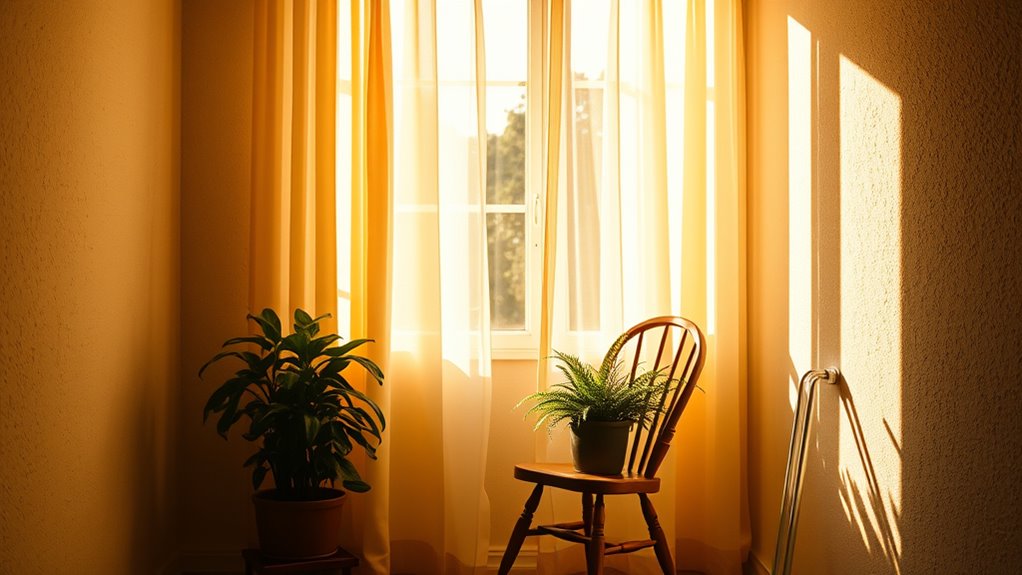Natural light has a bigger impact on your mood, productivity, and physical health than you might realize. It helps regulate your sleep-wake cycle, boosts vitamin D levels, and increases serotonin, making you feel happier and more alert. Proper exposure can reduce eye strain and improve mental clarity. By understanding its benefits, you can design your space and routines to maximize sunlight. Keep exploring to discover how integrating more natural light can transform your well-being.
Key Takeaways
- Natural light boosts mood, reduces depression, and combats Seasonal Affective Disorder through serotonin and vitamin D production.
- Exposure to sunlight regulates circadian rhythms, improving sleep quality, alertness, and overall mental health.
- Proper natural light enhances focus, productivity, and cognitive function in work and living spaces.
- Incorporating sunlight in design reduces reliance on artificial lighting, lowers energy costs, and creates healthier environments.
- Overexposure to artificial light and screens disrupts sleep and mood, highlighting the importance of natural daylight for well-being.
The Psychological Power of Sunlight

Sunlight has a profound impact on your mental well-being, influencing your mood and emotional health in ways you might not immediately realize. Exposure to natural light can trigger sunlight therapy, which helps combat seasonal affective disorder and boost your overall mood. When you get sunlight, your body engages in vitamin D synthesis, an essential process linked to improved mental health. Adequate vitamin D levels are associated with reduced depression and anxiety, making sunlight a natural mood booster. Even brief periods outdoors can elevate your spirits and help regulate your circadian rhythms, improving sleep and emotional stability. Recognizing the psychological power of sunlight encourages you to spend more time outside, harnessing its benefits for a healthier, happier mind. Additionally, understanding the effects of light therapy can further enhance your mental wellness strategies.
How Natural Light Enhances Productivity and Focus

Natural light plays a crucial role in boosting your productivity and focus throughout the day. Exposure to natural light helps regulate your circadian rhythms, keeping you alert and energized. It also enhances plant growth around your workspace, creating a healthier environment that supports concentration. When you get enough sunlight, your body synthesizes vitamin D, which is linked to improved mood and cognitive function. This boost in mental clarity allows you to work more efficiently, make better decisions, and stay motivated longer. Natural light reduces eye strain compared to artificial lighting, helping you maintain focus without discomfort. Additionally, embracing artistic expression and creativity can foster a more engaging workspace environment, further boosting your mental performance. Overall, integrating natural sunlight into your workspace not only benefits your physical health but also sharpens your mental performance, making it easier to stay attentive and productive.
Sunlight’s Role in Regulating Our Circadian Rhythms
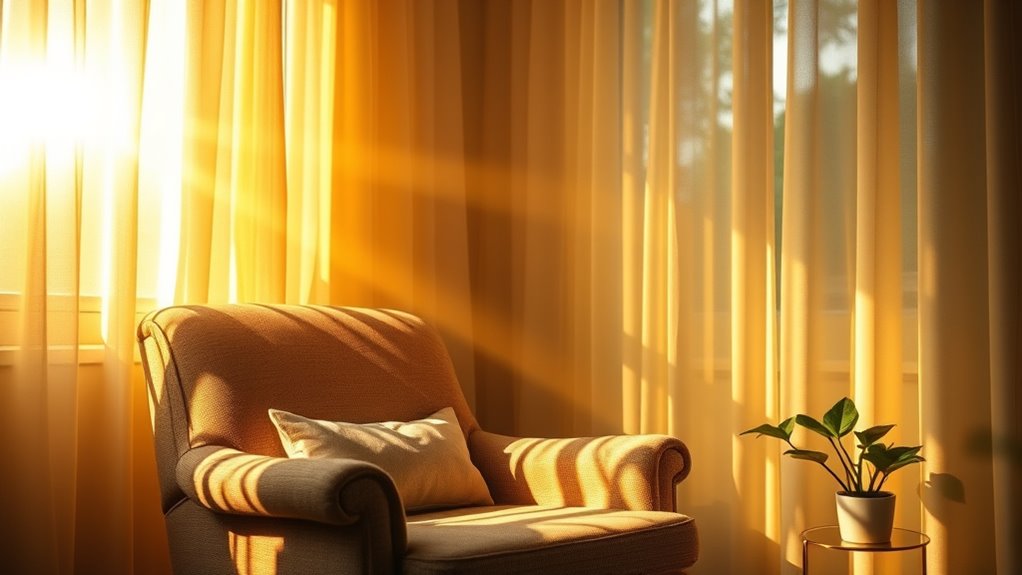
Since our bodies rely on light cues to synchronize internal clocks, exposure to sunlight is essential for maintaining healthy circadian rhythms. Sunlight helps regulate melatonin production, the hormone that signals your body when to sleep. When you get natural light during the day, it promotes circadian alignment, ensuring you feel alert and awake. Without enough sunlight, melatonin may be produced at inappropriate times, causing sleep disruptions and fatigue. To optimize this process, aim for outdoor exposure each morning or midday. Here’s a quick overview:
| Time of Day | Effect on Melatonin | Impact on Circadian Alignment |
|---|---|---|
| Morning | Suppresses melatonin | Sets day-night cycle |
| Afternoon | Maintains alertness | Reinforces rhythm |
| Evening | Promotes melatonin production | Prepares body for sleep |
| Night | Low light, high melatonin | Sleep readiness |
| Overcast days | Reduced effect | Slight delays in rhythm |
The Connection Between Light and Mood Improvement
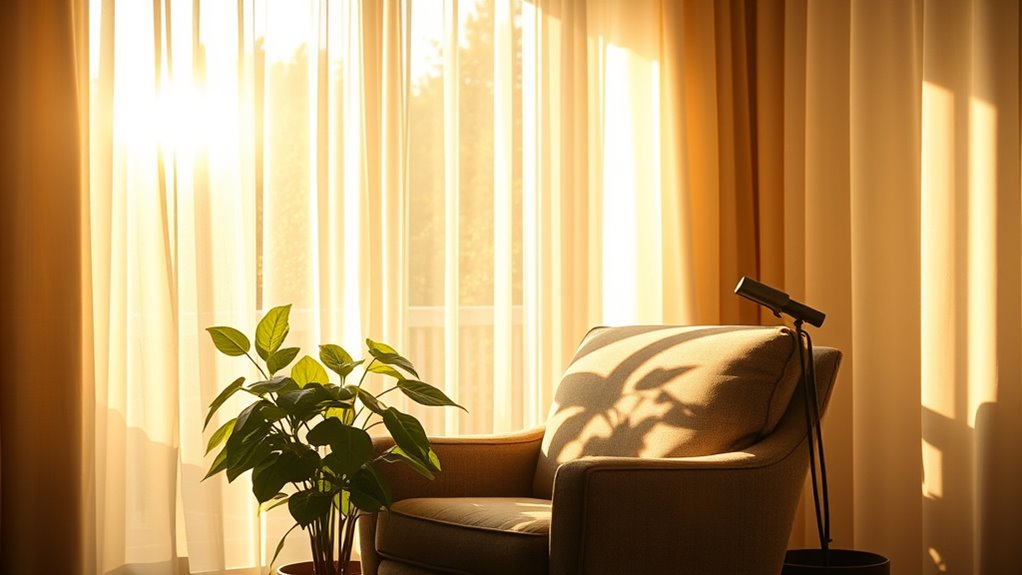
Light plays a crucial role in shaping your mood, influencing how you feel throughout the day. Natural light boosts your serotonin levels, helping you feel more alert and positive. Starting your morning with dawn meditation allows you to absorb early sunlight, setting a calm, uplifting tone. For those affected by seasonal affective disorder (SAD), exposure to bright natural light can considerably reduce depressive symptoms. Regularly spending time in sunlight helps regulate mood swings and combat feelings of sadness or lethargy common during darker months. Even brief outdoor breaks can improve your emotional well-being. Utilizing predictive modeling in educational data mining can help identify optimal times for sunlight exposure based on individual circadian rhythms, further supporting mental health. Recognizing this connection encourages you to seek sunlight actively, making small but impactful changes for better mental health and a more balanced outlook.
Natural Light and Its Impact on Physical Health

Exposure to natural light doesn’t just lift your mood; it also plays an essential role in supporting your physical health. Sunlight triggers your skin to produce Vitamin D, which is indispensable for bone strength, immune function, and overall vitality. Without enough natural light, you might experience deficiencies that affect your daily well-being. Additionally, proper exposure helps maintain healthy skin by promoting cell regeneration and reducing inflammation. To maximize these benefits, consider:
- Spending time outdoors during daylight hours
- Ensuring your skin is exposed to sunlight safely
- Incorporating natural light into your routine for better Vitamin D synthesis
- Being mindful of skin health to prevent sun damage
- Recognizing that symptoms of breast cancer can be linked to changes in physical health that may be mitigated through overall wellness practices
Designing Spaces to Maximize Sunlight Exposure

To maximize sunlight in your space, start with strategic window placement that captures the sun’s path throughout the day. Incorporate reflective surfaces inside to bounce light deeper into rooms, and consider adding skylights where possible for more direct sunlight. These design choices can markedly enhance natural illumination and overall well-being. Additionally, choosing nutrient-rich ingredients in your decor, like vibrant plants, can further improve your environment’s health benefits.
Optimal Window Placement
When planning the layout of a space, placing windows thoughtfully can considerably enhance natural sunlight. Focus on window orientation to maximize light during different seasons—south-facing windows bring in sun year-round, while east-facing ones catch morning light. Consider building materials; materials like glass maximize transparency, allowing more sunlight to enter. Position windows to avoid shading from nearby structures or trees, optimizing exposure. Think about the size and shape of windows: larger panes increase brightness, but also influence heat gain. Use strategic placement to balance light and privacy. Keep in mind that overexposure can cause glare or heat issues, so adjust window placement accordingly. Properly positioned windows create a bright, welcoming environment and reduce reliance on artificial lighting. Additionally, incorporating eye patches into a skincare routine can help maintain the health and appearance of the skin around windows exposed to sunlight, emphasizing the importance of skin protection in well-lit spaces.
Reflective Interior Surfaces
Strategic use of reflective interior surfaces can substantially boost natural light within a space. By incorporating materials like glossy paint, mirrors, or polished metals, you enhance the reflectivity of your environment. These surfaces bounce sunlight deeper into rooms, increasing interior brightness without additional windows or lighting. Placing mirrors opposite windows amplifies daylight, creating a more luminous atmosphere. Light-colored or high-gloss finishes on walls and ceilings also reflect more light, making your space feel open and airy. Keep in mind, however, that overly shiny surfaces can cause glare, so balance is key. When used thoughtfully, reflective surfaces maximize sunlight exposure, reducing your need for artificial lighting and fostering a healthier, more inviting environment. Incorporating rustic decor elements can complement reflective surfaces and enhance the cozy farmhouse ambiance.
Use of Skylights
Skylights offer an effective way to bring abundant natural light into your space by directly capturing sunlight from above. Proper skylight installation enhances daylight harvesting, reducing reliance on artificial lighting and lowering energy costs. To maximize benefits, consider the size and placement of your skylights, ensuring they face the sun’s path for best sunlight penetration. Incorporate energy-efficient glazing to prevent heat gain or loss. Keep these tips in mind:
- Choose skylights with adjustable shades for control over light levels
- Install skylights at angles that optimize sunlight during peak hours
- Use reflective surfaces around skylights to bounce light further
- Position skylights in rooms where natural light is most needed
- Recognize that angel numbers can provide spiritual guidance and insight to enhance your overall well-being and environment.
The Downsides of Artificial Lighting and Overexposure to Screens
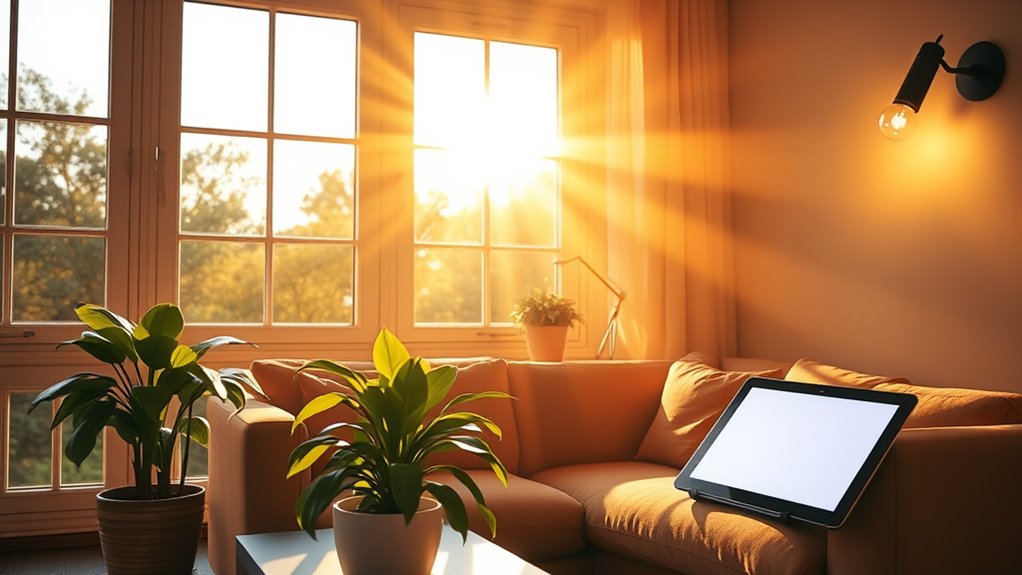
Artificial lighting and screen time can disrupt your sleep and leave your eyes feeling strained. Overexposure may also impact your mood and make it harder to focus. Recognizing these downsides helps you find better ways to protect your well-being. Limited‑edition artwork can provide a natural and calming visual environment, reducing the need for artificial illumination.
Disrupts Sleep Patterns
When you spend too much time under artificial lighting or staring at screens, your sleep patterns can suffer greatly. Exposure to artificial light, especially during evening hours, suppresses melatonin production, making it harder to fall asleep. This disruption can lead to poor sleep quality, fatigue, and even seasonal affective symptoms. Light pollution from streetlights and screens can also interfere with your circadian rhythm. To combat this, consider:
- Reducing screen time before bed
- Using dim, warm lighting in the evening
- Maximizing natural light during the day
- Being mindful of light pollution in your environment
Light exposure effects can significantly influence your sleep health and overall well-being.
Causes Eye Strain
Prolonged exposure to screens and bright lighting can lead to significant eye strain, causing discomfort and visual fatigue. Constant glare from screens makes it harder for your eyes to focus, leading to squinting and headaches. To reduce this strain, practice glare management by adjusting your screen brightness and using anti-glare filters. Over time, your eyes become tired and sensitive, which can impair your ability to see clearly. Incorporating light therapy with natural light helps balance your eye’s exposure, reducing reliance on harsh artificial lighting. Taking regular breaks, maintaining proper distance from screens, and optimizing lighting conditions all contribute to healthier eyes. Prioritizing natural light helps prevent eye strain and preserves your visual comfort throughout the day. Additionally, choosing restaurants with scenic views that incorporate ample natural lighting can enhance your overall well-being and reduce eye fatigue during meals.
Affects Mood and Focus
Overexposure to artificial lighting and screens can negatively impact your mood and ability to focus. Constant exposure may lead to feelings of irritability, fatigue, and decreased concentration. To combat this, consider incorporating indoor plants that naturally filter light and improve atmosphere. Light therapy lamps can also help boost your mood during darker days, mimicking natural sunlight. Additionally, overexposure can disrupt your circadian rhythm, making it harder to sleep and wake refreshed. You might notice a decline in motivation or mental clarity. Reducing screen time and maximizing natural light exposure are key. Remember, a well-lit space with indoor plants and occasional light therapy can markedly enhance your mental well-being and focus throughout the day. Recognizing how natural light influences our biological processes can further motivate you to seek more daylight in your routine.
Simple Ways to Bring More Natural Light Into Your Environment
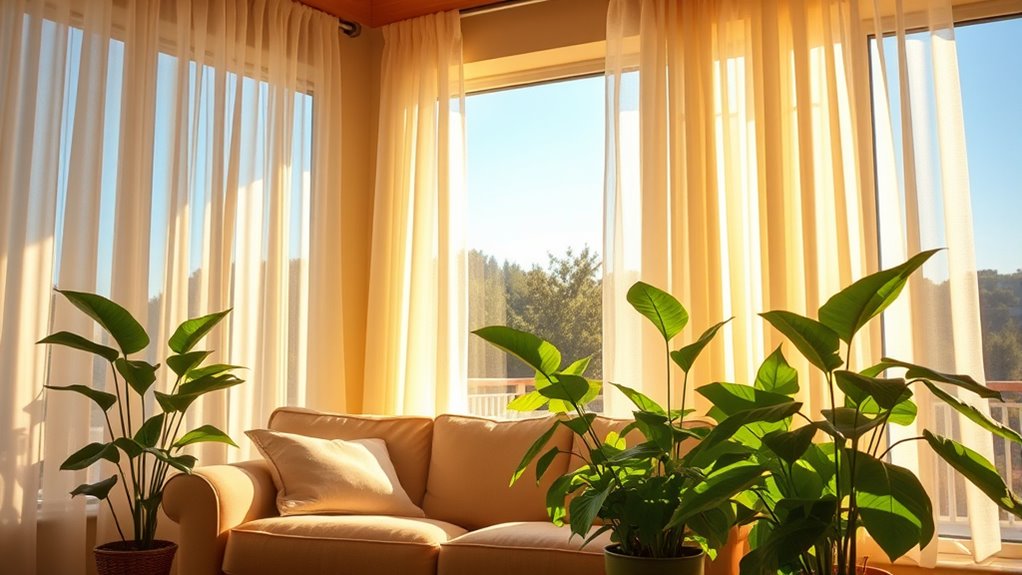
Bringing more natural light into your environment can be simple and highly effective. Start by opening your curtains or blinds each morning to let in sunlight, which boosts your mood and energy. Position your workspace near windows to maximize daylight exposure during the day. Consider using light-colored or reflective surfaces to bounce sunlight around the room. If you experience seasonal affective disorder, try incorporating sunlight therapy lamps to supplement natural light during darker months. These lamps mimic natural sunlight and can improve your mood and alertness. Keep window treatments minimal, avoiding heavy drapes that block light. Regularly declutter your space to allow light to flow freely. Incorporating natural light into your home design can further enhance brightness and reduce reliance on artificial lighting. Small adjustments like these can make a significant difference in how bright and inviting your environment feels.
Long-Term Benefits of Prioritizing Sunlight in Daily Life

Prioritizing sunlight in your daily routine can lead to lasting health and well-being benefits. Regular exposure helps your body produce Vitamin D, essential for strong bones and immune support. It also boosts your mood and mental clarity, reducing stress over time. Incorporating natural light encourages the growth of indoor plants, which improve air quality and create a calming environment. Additionally, consistent sunlight exposure can help regulate your sleep cycle, leading to better rest. When you make sunlight a priority, you also foster a healthier space where plants thrive, naturally enhancing your home’s atmosphere. Automation’s role in business intelligence can further optimize how you track and improve your health routines through data-driven insights.
Frequently Asked Questions
How Does Natural Light Influence Vitamin D Production?
Natural light plays a vital role in vitamin D synthesis. When you get skin exposure to sunlight, your body produces vitamin D naturally. The UVB rays trigger the process in your skin, helping your body create enough vitamin D to support bone health and immune function. Without adequate skin exposure to natural light, your vitamin D levels may drop, affecting overall health and well-being.
Can Natural Light Reduce the Need for Artificial Lighting?
Imagine the sun pouring through your windows like a gentle waterfall. Natural light can considerably reduce the need for artificial lighting, leading to energy savings. Plus, it boosts your mood, making you feel more energized and happier throughout the day. By maximizing daylight, you not only cut down on electricity costs but also create a brighter, more inviting space that supports your well-being.
What Are the Environmental Benefits of Increased Sunlight Exposure?
Increasing your sunlight exposure benefits the environment by boosting solar energy efficiency, reducing reliance on fossil fuels, and lowering greenhouse gas emissions. Sunlight also supports biodiversity by sustaining healthy ecosystems and natural habitats. When you harness more natural light, you contribute to a greener planet, conserve resources, and promote sustainable living. Your actions help protect the environment, making sunlight a essential resource for both energy and biodiversity.
How Does Sunlight Exposure Vary Across Different Seasons?
You’ll notice that seasonal daylight and sunlight duration change throughout the year. During summer, days are longer with more sunlight, giving you extended exposure, while winter days are shorter with less sunlight. These variations affect how much natural light you get daily, impacting your mood and health. Understanding these seasonal differences helps you plan your activities better and maximize the benefits of natural light regardless of the time of year.
Are There Specific Types of Natural Light That Are Most Beneficial?
While all natural light benefits you, the most beneficial types are those with a full light spectrum and high light intensity. Sunlight during the morning offers a balanced spectrum, boosting your mood and alertness. Direct sunlight provides intense light, enhancing vitamin D production, whereas diffuse light reduces glare. You should seek exposure to these types of natural light, especially in the morning, to optimize your physical and mental well-being.
Conclusion
Prioritizing natural light isn’t just a luxury—it’s essential. Studies show that people exposed to more daylight sleep better, feel happier, and are more productive. When you embrace sunlight daily, you boost your mood and support your physical health. Even small changes, like opening blinds or working near windows, can make a difference. So, make sunlight a priority; your body and mind will thank you for it.
